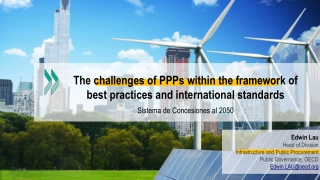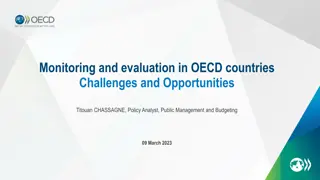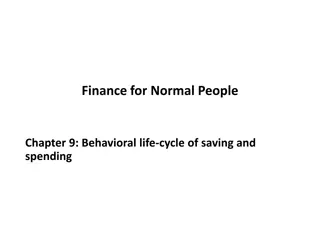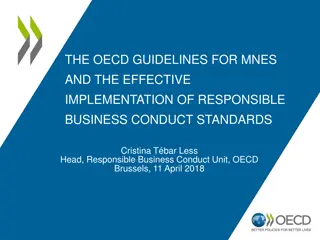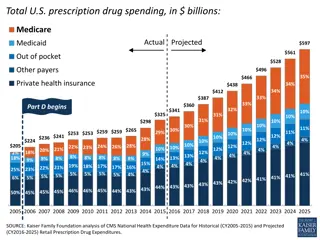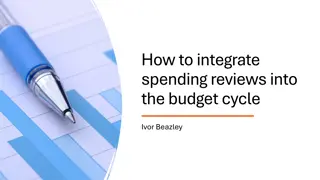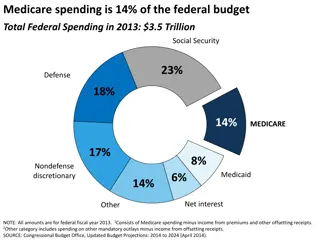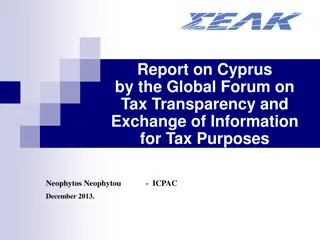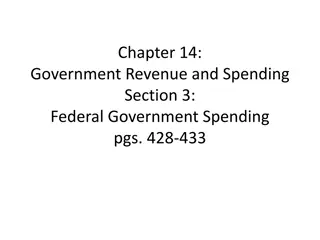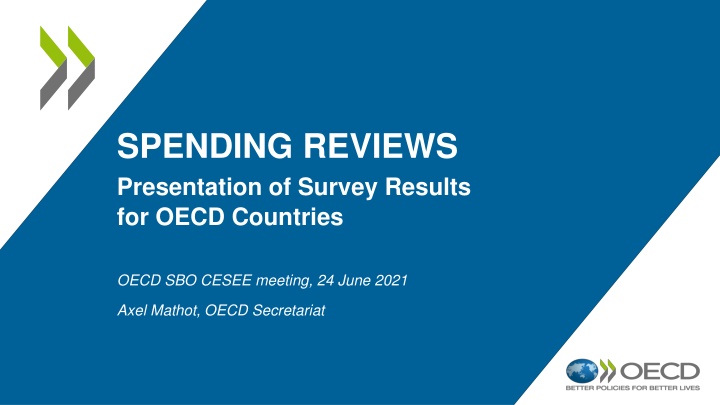
Survey Results on Spending Reviews for OECD Countries Presentation
"Explore survey results and insights on spending reviews for OECD countries presented at the OECD CESEE meeting. Topics include evolution, objectives, institutionalization, challenges, and impact of spending reviews. Learn how OECD countries are managing their total expenditures and aligning with government priorities. Discover the legal and methodological basis for spending reviews across OECD countries. Stay informed on the latest trends and shifts in spending review practices." (299 characters)
Download Presentation

Please find below an Image/Link to download the presentation.
The content on the website is provided AS IS for your information and personal use only. It may not be sold, licensed, or shared on other websites without obtaining consent from the author. If you encounter any issues during the download, it is possible that the publisher has removed the file from their server.
You are allowed to download the files provided on this website for personal or commercial use, subject to the condition that they are used lawfully. All files are the property of their respective owners.
The content on the website is provided AS IS for your information and personal use only. It may not be sold, licensed, or shared on other websites without obtaining consent from the author.
E N D
Presentation Transcript
SPENDING REVIEWS Presentation of Survey Results for OECD Countries OECD SBO CESEE meeting, 24 June 2021 Axel Mathot, OECD Secretariat
Presentation Overview 1. SR Evolution and objectives 2. Institutionalization of SR 3. Organizational structures 4. Coverage and scope of SR 5. SR impact 6. Challenges 7. Concluding remarks 2
1. The evolution of SR in OECD countries The number of OECD countries conducting SRs has increased over the past decade 4
1. Main objectives of SR in OECD countries Controlof the level of total expenditures has been an important objective since the beginning Improving effectiveness became a more important objective over the years This can change again due to the Covid-19 crisis - too early to say, but Over 70% of OECD countries state SR will become more important as a consequence of the COVID-19 crisis pre 2018 situation (2008-2017) 2018 2020 29 22 20 20 20 20 20 10 10 Control the level of total expenditure / savings Align expenditure to government priorities Improve effectiveness 5
2. Institutionalisation of SRs: legal and methodological basis in OECD countries A majority of OECD countries rely on provisions in the basic/organic budget, subsidiary legislation or ministerial orders as a legal basis Legal Basis (highest level) 0 Specific law on spending reviews Provision for spending reviews is included in the basic/organic budget law 6 Spending reviews are mandated in subsidiary legislation 12 5 Over 2/3 of the OECD countries implementing SR have standing methodologies or guidelines on SR Authority for spending review is given by ministerial order Other (Legal Basis) 8 3 No Legal Basis # of Countries 7
3. Key actors in the SR process in OECD countries Government Gives political commitment Approves the main elements of the review Ministry of Finance Takes the initiative to start the review in cooperation with line ministries Coordinates the review process Line Ministries Cooperate with the Ministry of Finance Participate in the review Implement the SR results External experts May participate in the review Cooperate with the Ministry of Finance Parliament Takes the review findings into account when approving the budget 9
3. Organisational arrangements of SR: actors responsible for decision-making in OECD countries # of Countries In most OECD countries, the Cabinet and a set of leading ministers play the most active roles in decision-making in the SR process Approval of spending review topics Approval of ToR Final decision-making on Spending Review Report 11 10 In some countries, the Minister of Finance autonomously decides on crucial decisions 6 3 4 1 2 2 4 6 8 7 In other countries, the Steering Group or Spending Review Unit make these decisions 5 4 2 Cabinet Minister of Finance and other minister(s) jointly Minister of Finance Steering Group Spending Review Unit 10
3. Organisational arrangements of SR: technical level in OECD countries Composition of Working group (# countries) Composition of Steering Group (# countries) 20 countries have Steering / Working groups Steering group involves mostly high level officials Working group mostly organised around MoF and LM (7 including experts) 5 8 11 12 4 High-level officials MoF and LM representatives are jointly the driving force of working group Political level (Ministers or Deputy) Other Other 11
4. Scope of SRs: different sizes of SRs in OECD countries % of OECD countries with narrow/medium/large scope of SRs in indicated year # of Spending Reviews in OECD countries More or less equal shares in large, medium and small SR Large SRs became relatively less important Number of spending reviews have been relatively stable over the last 5 years 0.7 250 0.6 200 0.5 150 0.4 0.3 100 0.2 50 0.1 0 0 2008 2009 2010 2011 2012 2013 2014 2015 2016 2017 2018 2019 2020 Narrow Medium Large # of Spending Reviews (est.) 13
5. SR IMPACT 14
5. How do SR results feed back into the budget process in OECD countries? In a majority of OECD countries, SR results are considered and closely linked with the budget process In most cases, direct linkages are mostly for selective cases only 2 7 11 11 11 10 # of Countries 15 10 8 Internal use in Line Ministries to prepare budget proposals Decision on SR are considered in the budget preparation process Decision on SR leads directly to insertion in annual budget Yes, for all or most cases Yes, for selective cases only No 15
5. SR impact (self-assessment) in OECD countries 16 15 14 12 10 8 6 # of 3 Countries 2 Objectives met in full or substantially Objectives largely unmet or not met at all Not assessed Control the level of total expenditure Align expenditure to priorities of the government Improve effectiveness within programmes and policies 16
6. Challenges in OECD countries Poor quality of performance information/data 3.1 Lack of performance information/data 3.1 Lack of time 2.9 Insufficient ownership from entities reviewed 2.8 Lack of capacity (e.g. available staff) 2.8 Insufficient cooperation from entities reviewed 2.8 Quantification and/or linking with budget process 2.7 Lack of capability (e.g. technical expertise, 2.6 Lack of attention on conducting spending reviews 2.6 Lack of political support (executive) 2.6 Gaming 2.5 Lack of ICT 2.3 Lack of framework 2.3 Lack of support (senior civil service) 2.2 Inadequate guidance/guidelines 2.1 1 = no challenge 2 = low 3 = medium 4 = high 18
Key potential issues of interest going forward 1. SRs have been widely introduced and practiced in OECD countries but still growing in importance in PEMPAL countries 2. SRs are a flexible tool where the main objectives can vary according to necessities 3. Options exist for developing standing legal and methodological bases, while also ensuring flexibility 4. There is a need to balance roles of civil servants and political level in SR organizational arrangement 5. Advantages exist in creating an SR Unit with options for its composition and responsibilities 6. The SR process should be closely aligned with the regular budget process Assessment mechanisms for SR impact should be fostered, ensuring that SR objectives are met, including reallocation stemming from alignment to government priorities 7. 8. Use of performance information in SRs is important 20
THANK YOU ! AXEL.MATHOT@OECD.ORG 21

